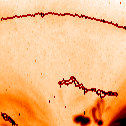  |
  |
The images above show the sudden appearance of a large structure in the north polar crown region. A contour overlay shows the location of the H-alpha filament and limb. The soft X-ray morphology calls to mind one of the original soft X-ray jets discovered by Yohkoh SXT (Strong et al., 1992), except that the 1991 jet was appropriately slender, whereas this one is fat. We checked the BBSO image archive for this time, and found that the appearance of the "fat jet" corresponded to the partial disappearance of a filament. The images above show (as contours) the filament configurations on Dec. 3 (day before) and Dec. 4 (just after) via Big Bear H-alpha. The phenomenon might thus be interpreted as a skinny arcade rather than a fat jet.
In any case, the appearance of the fat or skinny new structure followed more typical microflare and jet activity near its southern footpoint. Although a triggering relationship is always an extremely difficult matter to prove rigorously, we can speculate here that the microflare/jet activity triggered the large-scale event. However it is not very near the filament that erupted could in any way have communicated physically with the region showing microflare activity, so that the trigger action could have been independent of contact (ie, without direct magnetic-field reconnection).
Note the twisted appearance of the "after" image - that's not supposed to be there if helicity causes instability!
Suggestions welcome... a look at the EIT data would be worth the effort.